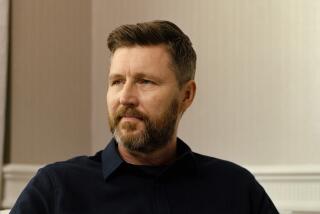DISCOVERIES
- Share via
STEPHEN KUUSISTO has John Milton’s gift. “The soul’s path,” he claims to have learned from the blind poet, “is in the ear -- not in the mirror.” Kuusisto’s blindness is not complete: He is able to see “colors and torn geometries.” “Blindness for me was veil after veil of forest colors,” he writes. “But what a thrill it was to be a sightless child in a city of sounds.”
“Eavesdropping” has two parts: The first is the author’s reconstruction of his childhood in Finland and the woods of New Hampshire. In Part 2, he describes his travels around the world: airports, Venetian canals, steaming lakes in Iceland, baseball games, New York subways.
Kuusisto, who is 50 and teaches English at Ohio State University, is a heart-stopping, sense-awakening, instinct-arousing writer. He makes the world larger with his descriptions of landscapes, rooms, conversations, birdsong: “By day the blackbird cried from the tunnel of his fever. The nuthatch sang like rain falling into a tin dish. These birds became my foreground. And a herring gull called because he was following the Oyster River and saw something glitter in the leaves.... One morning I found the wild orchid.... I heard the scrabbling feet of the pheasants in the leaves and I lay down to let the mauves and violets into my eyes.” He describes the “fat sound” of a horse breathing and the “corridor of footsteps” in the night ward where he lay as a child recovering from an operation on his eyes. He describes his loneliness when his alcoholic parents would send him off to his grandparents’ house in New Hampshire, where he spent hours with an old Victrola in the attic, listening to Caruso records -- and how he can hear the same loneliness in the music of Mstislav Rostropovich.
Kuusisto has spent a lifetime in what he calls “compensatory listening”: “Even when I listen to Manhattan traffic I’m drawing my own pictures of New York -- the streets are crowded with Russian ghosts and wheels that have broken loose from their carriages.” In his early teens, he began treating each day like a requiem. “You can think of a whole day as a musical pattern,” he explains -- the opening, the Dies Irae, the Tuba Mirum.
In Part 2, we float with the author through various landscapes, some (like an airport) more threatening than others. “When the sighted look you over,” he says of a man whose scrutiny he senses, “it feels like you’ve walked into a ghost in the woods.” He hears the sounds of caged birds in Venice echoing through the canals; he hears the clacking of a woman’s knitting needles on a late-night subway ride. In Fenway Park, he overhears two fans on acid describe Pedro Martinez, then pitcher for the Boston Red Sox, who “sheds strands of iridescence: long moonglow strings of light as he throws.”
As a disabled child, Kuusisto (whose name means “grove of spruce” in Finnish) often found himself on the margins, a blessing that allowed him long -- albeit often lonely -- hours in nature. “Writers are all orphans of a kind,” he writes. “But I learned my listening early. Knew the cicadas from the katydids. Knew starlings from grackles.” He remembers sitting among spruce trees as a child, listening to the clicking of crows’ beaks: “Dry old wood in a dry climate. Sound of an old man’s knees.... The sound of oars along the Nile.... First sound of ancestor worship.”
This is writing that enriches the reader’s life by heightening the reader’s senses. Amazing to be reminded that flat, stolid letters on a page can actually course through one’s veins, can cause the synapses in one’s brain to transmit their hopeful message: There’s more! There’s more! There’s so much more than meets the eye!
*
More to Read
Sign up for our Book Club newsletter
Get the latest news, events and more from the Los Angeles Times Book Club, and help us get L.A. reading and talking.
You may occasionally receive promotional content from the Los Angeles Times.








